Revised 17 February 2022
Accepted 24 October 2022
Available Online 21 November 2022
- DOI
- https://doi.org/10.55060/s.atssh.221107.006
- Keywords
- Fiber art
Traditional skills
Inheritance
Innovation - Abstract
This article takes the revitalization of traditional skills as the starting point, and explores the value and significance of traditional crafts in contemporary fiber art by sorting out and analyzing the works of fiber artists, deconstructing their symbols, the causes of style, and the integration of new technologies. The continuous holding of the International Fiber Art Biennale not only enhances the international influence of Chinese fiber art, but also plays an essential role in protecting the inheritance of traditional weaving and embroidery, and drives the comprehensive development of the arts and crafts industry and the promotion of cultural value, in order to provide reference for the inheritance and innovation of handicrafts of all ethnic groups.
- Copyright
- © 2022 The Authors. Published by Athena International Publishing B.V.
- Open Access
- This is an open access article distributed under the CC BY-NC 4.0 license (https://creativecommons.org/licenses/by-nc/4.0/).
1. INTRODUCTION
In today's rapid economic development, on the basis of conforming to the national policy of revival of traditional handicrafts and exploring the added value of cultural products, the power of science and technology can be used to stimulate the inherent vitality and infinite potential of traditional crafts, in order to realize the diverse expression of culture and innovative development of tradition. In the National 13th Five-Year Plan for Economic Construction and Development Outline, the “formulation and implementation of the revitalization plan for Chinese traditional craftsmanship” [1] is proposed to promote the inheritance and revitalization of Chinese traditional craftsmanship. Weaving and embroidery were included in the first batch of national traditional handicraft revitalization catalogues. The development of traditional handicrafts can no longer meet people's growing spiritual and cultural needs. It is imminent to seek an innovative development model of handicrafts and revive traditional national handicrafts.
The inheritance of traditional craftsmanship is the foundation of the development and innovation of fiber art, and fiber art is a comprehensive art form developed on the basis of traditional craftsmanship and the fusion of various materials. The traditional skills involved include weaving, embroidery, printing and dyeing, felt and other traditional crafts.
The cases in this paper list two different traditional craft forms, namely weaving and embroidery. Based on the analysis of the works of Lin Lecheng and Liang Xuefang, two representative fiber artists, both are successful cases of using traditional techniques to transform into fiber art creation. They are highly innovative and contribute to the revival of traditional craftsmanship, and are worthy of reference for innovation by art creators and industry masters.
2. FIBER ART CREATION UNDER THE TRANSFORMATION OF WEAVING SKILLS
Fiber art is created from a soft and warm material. It originated from the ancient tapestry art in the West, and it continuously integrates other art forms in the process of development. Weaving has a history of thousands of years in China. It has its own unique artistic charm, heart-warming, and includes the artistic characteristics of painting and sculpture. The soft characteristics of wool, cotton, silk, linen and other fiber materials are more likely to give people a warm emotional resonance. In the process of development, modern fiber art and traditional weaving technology are in a relationship of mutual integration and promotion. Modern fiber art expresses the spiritual emotions of contemporary people with the help of traditional weaving technology, meanwhile, traditional weaving technology reflects its profound cultural value through the innovation of modern fiber art.
Lin Lecheng, a professor at the Academy of Fine Arts of Tsinghua University in China, has been engaged in fiber art teaching and fiber research for 40 years, and his works are mainly weaving. He advocates expanding horizons in application practice and integrating classic traditional craftsmanship into contemporary design. The style of Lin Lecheng's fiber art works is compatible with tradition and contemporary. His expression and grasp of “meaning” and his views on artistic creation can be summarized into three points: the beauty of artistic conception originating from the perception in nature; the natural expression of spirit under the fusion of affection; the love and respect for human civilization and traditional culture. He has traveled all over the world, constantly sketching and creating, and many of his works are inspired by images of mountains, rivers, the earth, clouds, birds and beasts. The most characteristic feature of Lin Lecheng's artistic creation is the genuine integration of nature and emotion in the creation, the vivid and lively objects depicted, and the magnificence of the beauty of natural artistic conception.
He long studied the sense of form and expressiveness of fiber art works and has a deep understanding of the traditional cultural spirit and artistic conception. From Lin Lecheng's works, people can see the influence of traditional elements such as patterns of the painted pottery period, picture stones and picture bricks of the Han Dynasty, and cursive script, and understand and inherit the traditional cultural spirit and artistic conception. Lin Lecheng's proficiency in expressing traditional themes stems from his long-term training in traditional craftsmanship. Traditional skills and culture have always been the foundation of his artistic creation (Fig. 1).
The different materials and themes in Lin Lecheng's artworks are his unique artistic language. This artistic language combines different artistic techniques from the East and the West. Understanding and grasping skills is the foundation of creation. From his works, it can be seen that his creation is not only an in-depth explanation of traditional culture, but also a re-creation of weaving skills. In his hands, the craft language of weaving is not only the craft itself, but also a part of the artistic language. In the process of creation, the beauty of the form of weaving is integrated, so his works have both weaving craftsmanship and weaving interest, showing his unique and magnificent imagery [2].
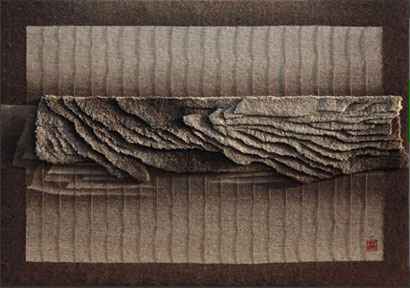
Lin Lecheng’s “Childhood Memory” (2016) wool weaving. Collection: Guanshanyue Art Museum, China.
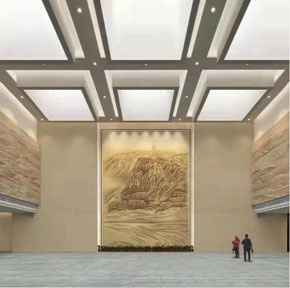
Lin Lecheng’s “Pagoda Mountain · Loess Soul” (2019) wool weaving.
Lin Lecheng's work “Pagoda Mountain · Loess Soul” (Fig. 2) is made of warm and soft natural wool material. The Yan'an Pagoda is the spiritual symbol of the Chinese revolution. The color of the work is chosen as the brownish-yellow gradient of the Loess Plateau, showing a stable and elegant, traces of the loss of time, and at the same time, it echoes with the surrounding tall architectural space environment and is harmonious and unified. The whole work inherits the lines and composition of traditional paintings, without deliberately emphasizing details, but more on the revealing of the overall charm, making people feel the profound implication of Chinese artistic spirit in the undulating mountains, in the majestic mountains and clouds, and in the lines of flowing water. Combining Gobelin's weaving skills and “tufting” skillfully, it highlights the unique weaving layers and texture effects of fiber art, creating a unique and soft relief, and landscape paintings become touchable and approachable three-dimensional textured wool. The cold modern architecture permeates the breath of nature, and in this architectural space, the dialogue continues between the weak and the strong, the contemporary and the historical. It makes people feel warm, cordial and solemn, paying tribute to Yan'an, the Holy Land of the Chinese Revolution.
Traditional culture is the foundation of Lin Lecheng's creation. The weaving works of traditional Chinese themes are perfectly integrated with the environment and have a vivid charm. The transcendent embodiment of the beauty of Lin Lecheng's fiber art imagery shows that his artistic pursuit and exploration have been progressive and never stopped. Lin Lecheng has highly refined, generalized and expressed nature through the expression of symbolic art. Not only is it unique in reshaping the natural form, but also expresses a personal eulogy to nature and a valuable perception of life. This has played an important reference role for the successful innovation and transformation of today's traditional skills.
3. FIBER ART CREATION UNDER THE TRANSFORMATION OF TRADITIONAL EMBROIDERY TECHNIQUES
The inheritance and development of embroidery is closely related to fiber art, and the study of traditional embroidery as a formal language will allow more people to understand the value conversion of embroidery in fiber art.
Liang Xuefang, a master of Suzhou embroidery arts and crafts, has been doing embroidery since childhood. She believes that embroidery is not just an imitation of traditional painting, but innovation in inheritance is an effective way for the embroidery industry to break the circle and keep up with the times. Liang Xuefang has been studying traditional embroidery skills seriously and deeply for many years, creating creations based on her own cultivation and perception in nature, and turning the essence of nature into fresh design elements, which are injected into the creation of modern fiber art. In 2014, Liang Xuefang's embroidery work “If You Blooming” (Fig. 3) was awarded the Gold Award in the 8th International Fiber Art Biennale “From Lausanne to Beijing”, becoming a veritable fiber artist.
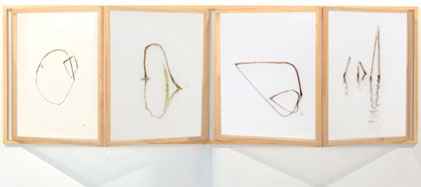
Liang Xuefang’s “If You Blooming” (2014) embroidery craft.
Liang Xuefang's embroidery works are natural, simple and contemporary in style, with a few strokes full of ink and Zen. She often borrows the element of lotus to convey her perception of life. For decades, she has often observed the scene of a lotus seed blossoming and bearing fruit by the lotus pond. Combined with the silkworm baby spinning silk as a cocoon, a trace of the endless life cycle of a thousand meters, reminiscent of the human life is like a lotus, like a silkworm's self-improvement will, so needles are used as a substitute for writing and silk is used as ink to describe the vital signs of lotus flowers. The twists and turns in the work “Lotus Rhyme” (Fig. 4) are like ink painting, showing Liang Xuefang's meticulous observation and understanding of inner vitality. Liang Xuefang's embroidery works pursue the expression of “natural and exquisite” artistic conception and return to the true language of embroidery. This is the natural expression she explores in her continuous self-cultivation, interpreting life, breathing and breathing. It is a practice that returns to nature.
Through in-depth research on Liang Xuefang's embroidery, branches and leaves of natural crops are extracted and integrated into her delicate embroidery works, turning into abstract simple and interesting geometric line aesthetics. The exquisite grasp of the composition of the work, and the large area of blank space in the picture, reflects the ethereal beauty of Zen. Influenced by Liang Xuefang, the researcher also created a series of embroidery works, expressing the devout love for nature and the constant pursuit of a “Zen interest” life [3].
4. DEVELOPMENT OF MEDIA PROMOTES TRANSFORMATION OF NEW FORMS OF FIBER ART
With the development of science and technology, fiber art has gradually formed a free and all-encompassing art from the initial practical art. The integration of new technologies provides a broader space for exploration and innovation for human spirit and sensory experience. Once vision fails to satisfy the freshness of users or viewers' attention in terms of design innovation, it will naturally reduce the attractiveness of products, and the same is true for works of art. Sensory replacement is one of the means to reduce the homogeneity of art works and enhance the innovation of fiber art.
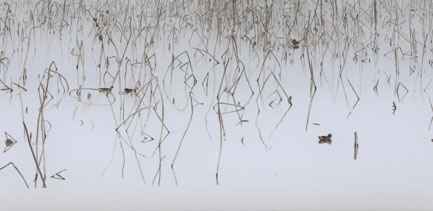
Liang Xuefang’s “Lotus Rhyme” (2011) embroidery craft. Collection: British Museum, UK.
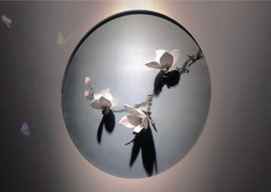
Gao Jing’s “Mulan” (2018) dynamic three-dimensional embroidery.
The work “Mulan” (Fig. 5) by young artist Gao Jing is made by combining traditional Hunan embroidery techniques and technology. It is a dynamic three-dimensional embroidery fiber artwork based on the image of Mulan, which reproduces the beautiful scene of flowers growing in nature. The production method is to use the circuit to control the current to supply heat to the deformed metal material, and then cause the deformation, and use the infrared sensor to sense the audience. When the audience approaches, the circuit control will be triggered. The principle is to use a new material – flexible deformation memory alloy – as power skeleton to drive free opening and closing of magnolia petals. In this work, the viewer first feels the elegant charm of traditional handicraft art, and then feels the surprise brought by technology [4].

Liang Xuefang & Liu Mingxin: “Electrical Machinery and Lotus Dew” (2021) embroidery and mechanical installation.
Liang Xuefang's latest work “Electrical Machinery and Lotus Dew” (Fig. 6) also breaks the previous display method, turning the flat embroidery into an interactive installation work, adding a multimedia mechanical lever to it, the lever rotates left and right, and the dewdrops rotate back and forth with the lever, which fully demonstrates the bold attempt of the artist to innovate and create. Due to the nanotechnology on the embroidered silk cloth, the water droplets can rotate freely on the embroidered cloth surface without soaking the silk cloth, which is like the vivid scenery of dew on the lotus leaf rolling in the wind after the rain.
The work “Five Pairs of Eyes” (Fig. 7) by embroidery master Yao Jianping and artist Qiu Zhijie also uses embroidery combined with program-controlled motors, infrared induction systems and stainless steel. The five pairs of eyes are opened and closed, and are constantly turned up and down under the drive of the program-controlled motor. The front and back sides are quickly presented in front of the audience. In the dark background, the wonderful effect of blinking eyes is formed. When people approach, the infrared sensor system will stop the movement when it detects people. The whole work is full of interest, which breaks the inherent form of traditional techniques that are only static frames on easel. Combination of technology and skills provides more possibilities for contemporary fiber art [5].
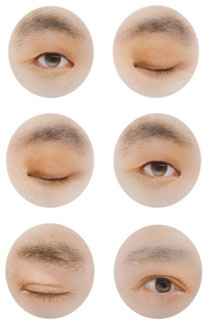
Qiu Zhijie & Yao Jianping: “Five Pairs of Eyes” (2021) embroidery and mechanical installation (dimensions variable).
In relation to today's highly integrated development of science and technology, the combination of art and technology will become the norm, not only expanding the dimension of traditional craftsmanship, but also extending the depth of the connotation of fiber art. Development of science and technology not only provides people with convenient lives, but also makes them believe that in the future, traditional crafts and contemporary fiber art will present more diverse and colorful cooperation models.
5. CONCLUSION
In recent years, the revitalization of traditional crafts has gradually attracted the attention of China, emphasizing the protection of the continuity of the traditional culture, and promoting the cross-disciplinary cooperation in fiber art creation. Starting from the practical needs of protecting traditional crafts, people try to carry out technological innovation, material innovation, and expand the combination of art and technology to achieve diversified development.
Relevant exhibitions in the field of fiber art continue to happen, well-known artists use traditional crafts to carry out creative transformations, and cooperation between industrial arts and crafts masters and artists cross-border, etc., all are to make the public pay more attention to and protect traditional national skills. At the same time, it injects fresh and powerful cultural power into development of contemporary fiber art. Fiber art works created from the perspective of craft revitalization establish a clear attitude and position, and provide clear direction and new ideas for the new development of fiber art. Inheritance and innovation of culture must be carried out continuously, gradually realize the sustainable development of culture, economy and ecology, and improve people's life, and then improve the concept of life in rural areas, build beautiful homes, inherit and revive traditional excellent culture, and improve national cultural self-confidence. Fiber art is intervening in this process in diverse and unique ways.
REFERENCES
Cite This Article

TY - CONF AU - Yifan Zhang PY - 2022 DA - 2022/11/21 TI - Transformation of Traditional Skills in Contemporary Fiber Art BT - Proceedings of the 8th International Conference on Arts, Design and Contemporary Education (ICADCE 2022) PB - Athena Publishing SP - 25 EP - 30 SN - 2949-8937 UR - https://doi.org/10.55060/s.atssh.221107.006 DO - https://doi.org/10.55060/s.atssh.221107.006 ID - Zhang2022 ER -









